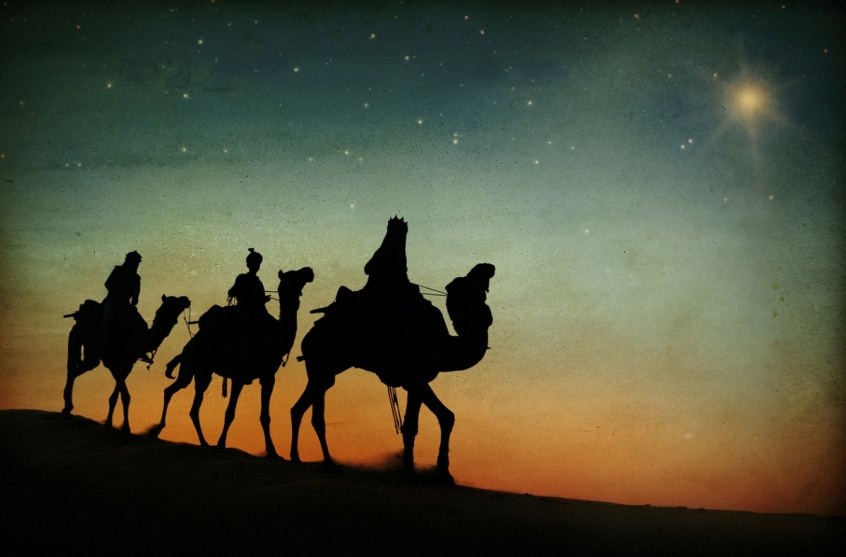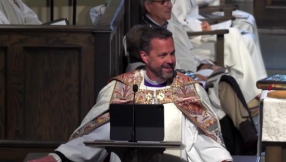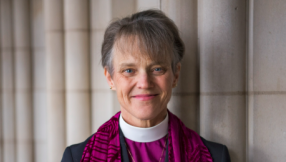
One of the strangest aspects of the beginning of the life of Jesus is found in the account of the visit of the magi. But, first, a reminder of what is in the New Testament...
"O little town of Bethlehem..." – the Gospels and Christmas
The Gospel of Luke contains the main traditions now associated with Christmas: a Roman census; the journey of Mary and Joseph to Bethlehem; no room for them to stay; Jesus placed in a manger; angels appearing to the shepherds, who hurry to Bethlehem.
There are no birth narratives in Mark's Gospel or in the Gospel of John. In Mark, Jesus bursts onto the scene as a man – sometime, we assume from other evidence, around the year 30 AD. In John there is the famous Prologue which reflects on the divine nature of Jesus.
Matthew, on the other hand, contains no birth traditions, but provides us with an extraordinary account of strange visitors who appear when Jesus is a toddler.
Today (though traditionally celebrated at Epiphany on 6 January) it has become very much part of the Christmas story. We see the 'Three Wise Men' on Christmas cards and in nativity plays, along with Mary and Joseph in the stable, the angels and the shepherds.
What does Matthew actually tell us?
In Matthew chapter 1:18-25 we hear of: Mary's pregnancy by divine power; Joseph's plan to set her aside, due to her pregnancy; an angelic messenger who reassures him in a dream that "the child conceived in her is from the Holy Spirit" (Matthew 1:20); instruction that the child should be called Jesus "for he will save his people from their sins" (v.21); a statement that this fulfils a prophecy in the Old Testament book of the prophet Isaiah; Joseph's rescinding of his original divorce plans, and his subsequent marriage to Mary, but having no sexual relations with her until after Jesus is born.
Then, in chapter 2, Matthew recounts the visit of the – unnumbered – 'magi' (the 'We Three Kings' of the carol and of nativity plays) to Jesus in Bethlehem, guided by a star. This clearly is not a birth tradition as such, since there are indications within this account which suggest that Jesus may have been as old as two years when this event occurred. However, as we have seen, it is now very much part of the 'Christmas story.'
The importance of 'mental maps'
It seems that Luke and Matthew had contrasting 'mental maps' in mind. For Luke it started in Galilee, then moved to Bethlehem in Judea, and then back to Galilee. For Matthew it is all Judean focused (Jerusalem/Bethlehem), then to Egypt as refugees, and finally to Galilee due to specific threats still being located in Judea.
Both clearly knew that Galilee was the epicentre of the later 'Jesus movement,' while understanding that Jerusalem was both the spiritual heartland of Judaism and the crucial location of the dramatic conclusion of Jesus' life and ministry. For Luke, the story started in Galilee. For Matthew it started in Jerusalem. They simply focused on different places as the starting points of their accounts; both places played major parts in the life of Jesus.
Which brings us back to the 'Three Wise Men.'
The role of the 'magi' in the Gospel of Matthew
For Matthew, the dramatic arrival of these strange visitors is the way by which he begins his exploration of the life of Jesus. These are the famous 'magi' and the significance of this description we will explore shortly.
The account starts with a visit by them to Herod in Jerusalem; it is followed by their arrival at a "house" in Bethlehem, to see Jesus; then giving the famous gifts; finally dream-warnings occur, to the magi and to Joseph, concerning Herod's murderous intentions; consequently, the magi leave without returning to Herod. It is after this that the family flee to Egypt and Herod massacres the children in Bethlehem.
After Herod's death, another angelic messenger tells Joseph it is safe to return, but Joseph fears the intentions of Herod's son, Herod Archelaus, and so the family move from Egypt to Nazareth, in Galilee. Throughout his account, Matthew anchors events in what he describes as prophecies fulfilled (virgin birth, messiah born in Bethlehem, the flight to Egypt, the massacre of the children, Jesus being "a Nazorean").
For Matthew, it is significant that the story of Jesus begins in Judea under the rule of King Herod. Here, Herod is presented as a new pharaoh set on the murder of children (as pharaoh did in the book of Exodus); but failing to kill the targeted one (Jesus), just as pharaoh failed to kill the one appointed to God's special task (Moses). However, one greater than Moses is targeted here. The parallel with Moses (and, implicitly, with the Old Testament Exodus from Egypt) seems clear. The whole episode with the magi is used by Matthew to imply that a new Exodus (with its liberation from slavery and establishment of a covenant relationship with God) has been achieved through the coming of Jesus (the new and superior 'Moses').
The account of Jesus' birth is also implicitly linked to King David by the explicit reference to "Bethlehem of Judea" (David's hometown), to avoid any confusion with another Bethlehem, in Zebulun (at the southern end of the Galilee region). This further emphasises Jesus' kingly and messianic status.
The arrival of the people described as 'magoi,' with their gifts of gold, frankincense, and myrrh was clearly meant to underscore the message that God's relationship with the Jewish people has broken out of ethnic boundaries, since these travellers are representatives of pagan culture ('magoi' is related to the modern word 'magician,' though we often sanitise it as 'wise men') who have been brought to recognise God's Messiah through direct revelation from God (via the star).
The term 'magoi' is derived from a Persian word ('magush') referring to a class of astrologer. So, they probably originated in what is today Iran. They may have been Zoroastrians. It is clearly such star-studying experts that Matthew is asserting travelled in search of the new-born king. We have no idea how many of them there were. We simply know that there were three gifts or types of gift. From the sixth century onwards, the magi are given names and ethnicities, but not before this.
The gifts are often interpreted as having specific symbolic meanings: gold (royalty), frankincense (worship), and myrrh (anointing for burial). However, the Old Testament suggests that all were gifts fit for a king: gold (Psalm 72:15), frankincense (Song of Solomon 3:6), and myrrh (Psalm 45:8). Matthew does not interpret their meaning.
The magi's journey and worship stand in stark contrast to Herod and the people of Jerusalem and it is significant that Matthew presents this as: "When King Herod heard this [a child born king of the Jews], he was frightened, and all Jerusalem with him" (Matthew 2:3). One must remember that, by the time Matthew wrote his gospel, Judaism and the emerging Christian community were parting ways. For Matthew, the arrival of the magi points towards this, and the explosion of the gospel into Gentile communities.
The star...
No image of the magi is complete without the 'star.' There are no parallels to the star/magi in the other gospels and the Greek contains expressions highly characteristic of Matthew's Gospel, which suggests that this was a tradition unique to Matthew and his source(s).
A number of suggestions have been made regarding the astronomical phenomenon described by Matthew: in 6 BC Jupiter had a 'heliacal rising' (appearing as the morning star); it has been suggested that Jupiter crossed the paths of both Venus and Saturn in 7 BC; an eclipse of Jupiter by the moon in 6 BC may have represented a regal portent; or it may refer to a comet which (according to Chinese sources) appeared for seventy days in 5 BC.
Any and all of these phenomena may have been regarded as highly significant by astrologers. And it should be remembered that there are errors in our BC/AD dating system and that Jesus was, most likely, born in about 6 BC.
On the other hand, Matthew clearly states that the star went "ahead of them" and "stopped over the place where the child was" (Matthew 2:9) which does not seem to describe the kind of phenomena that we have just suggested. In which case, Matthew had something in mind either more miraculous (that cannot be tested by astronomical analysis) or theologically symbolic.
In the Old Testament, in Numbers 24:17, we hear that "a star shall come out of Jacob, and a sceptre shall rise out of Israel". The second-century AD Jewish nationalist (messianic?) leader, Simon bar Kokhba, appears to have adopted this name, meaning "Son of the Star", as a result of its messianic connection.
So, it has been suggested, Matthew may have had something more symbolic in mind than literal astronomical phenomena. On the other hand, he may have known that a celestial event had indeed occurred about the time of the birth of Jesus and understood it as a sign of cosmic significance.
Intriguingly, the Greek writer Ptolemy (died c. 170 AD) explained that heliacally-rising planets can appear "stationary." And Geminus of Rhodes (possibly died c. 60 AD) used the same verb that lies behind Matthew's "ahead of them" to describe what is called 'planetary retrograde motion'. Consequently, this suggests that Matthew's account is more astronomically accurate than is sometimes given credence, and that it used contemporary terms to describe a historical phenomenon, albeit one then presented in a messianic way.
Why the magi are so important to us
The magi were clearly very important to Matthew. They are also very important to us. They remind us that the message of Jesus cannot be constrained within ethnic, national, or cultural boundaries. It is universal in its impact. It reaches out to all, including those who might seem far from 'acceptable' according to our expectations. They are also a reminder of how God can reveal himself to people through their own cultural experiences and practices.
Finally, they declare a radical new kind of kingship. The gifts speak of messianic royalty – but refer to a child who becomes a political refugee, homeless and hunted by a tyrannical ruler. This confronts and challenges earthly power, comfortable expectations, and the status quo. As always, the magi make an unexpected, disturbing, and unsettling contribution to the nativity play.
Martyn Whittock is an evangelical and a Licensed Lay Minister in the Church of England. As an historian and author, or co-author, of fifty-four books, his work covers a wide range of historical and theological themes. In addition, as a commentator and columnist, he has written for a number of print and online news platforms; has been interviewed on radio shows exploring the interaction of faith and politics; and appeared on Sky News discussing political events in the USA. His most recent books include: Trump and the Puritans (2020), The Secret History of Soviet Russia's Police State (2020), Daughters of Eve (2021), The End Times, Again? (2021) and The Story of the Cross (2021). The role and the significance of the magi is explored (alongside other New Testament evidence) in: Jesus the Unauthorized Biography (2021), co-written with his youngest daughter.













